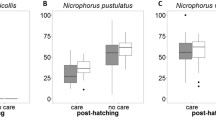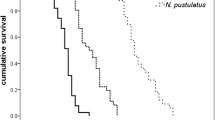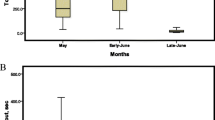Abstract
We investigated food sharing behavior in 5 litters of pied bare-faced tamarins (Saguinus bicolor bicolor)—8 infants, from 3 families—from 5 to 26 weeks of age. The frequency of sharing by parents in response to infant begging increased steadily from the age of 5 weeks to 16 weeks, and then declined. Offering of food by adults without prior infant begging occurred at very low frequencies throughout observations (1.5% of total items transferred). On average, infants received approximately equal amounts of food from transfers from others and by self feeding until about 20 weeks, after which self feeding began to predominate. Begging success—the proportion of infant begs which resulted in food sharing—remained relatively constant over time, at 60–70%. Overall, therefore, the frequency of food sharing seemed to be governed by changes in infant rather than adult behavior. There were individual differences between adults in their response to infant begging, but two of three fathers transferred significantly more food to infants than mothers did. The results of this study emphasize the existence of specific and individual differences in food-sharing behavior, which must be taken into account in explaining its importance in the reproductive strategies of the Callitrichidae.
Similar content being viewed by others
REFERENCES
Brown, K., and Mack, D. S. (1978). Food sharing among captive Leontopithecus rosalia. Folia Primatol. 29: 268–290.
Courts, S. E. (1995). The Jersey Wildlife Preservation Trust Dietary Manual. Jersey Wildlife Preservation Trust, Jersey.
Egler, S. G. (1992). Feeding ecology of Saguinus bicolor bicolor (Callitrichidae: Primates) in a relict forest in Manuas, Brazilian Amazonia. Folia Primatol. 59: 61–76.
Feistner, A. T. C. (1985). Food-sharing in the Cotton-Top Tamarin (Saguinus oedipus oedipus). MSc thesis, University of Stirling.
Feistner, A. T. C., and Chamove, A. S. (1986). High motivation toward food increases food-sharing in cotton-top tamarins. Dev. Psychobiol. 19: 439–452.
Feistner, A.T.C., and Price, E. C. (1990). Food-sharing in cotton-top tamarins, Saguinus oedipus. Folia Primatol. 54: 34–45.
Feistner, A. T. C., and Price, E. C. (1991). Food offering in New World primates: two species added. Folia Primatol. 57: 165–168.
Feistner, A.T.C., and Price, E. C. (1999). Cross-generic food-sharing in tamarins. Int. J. Primatol. 20: 231–236.
Ferrari, S. F. (1987). Food transfer in a wild marmoset group. Folia Primatol. 48: 203–206.
Ferrari, S. F. (1993). Ecological differentiation in the Callitrichidae. In Rylands, A. B. (ed.), Marmosets and Tamarins. Systematics, Behaviour, and Ecology, Oxford University Press, Oxford, pp. 314–328.
Ferrari, S. F., and Lopes Ferrari, M. A. (1989). A re-evaluation of the social organisation of the Callitrichidae, with reference to the ecological differences between genera. Folia Primatol 52: 132–147.
Garber, P. A. (1993). Feeding ecology and behaviour of the genus Saguinus. In Rylands, A. B. (ed.), Marmosets and Tamarins. Systematics, Behaviour, and Ecology, Oxford University Press, Oxford, pp. 273–295.
Garber, P. A., and Leigh, S. R. (1997). Ontogenetic variation in small-bodied New World primates: Implications for patterns of reproduction and infant care. Folia Primatol. 68: 1–22.
Goldizen, A. W. (1987). Facultative polyandry and the role of infant-carrying in wild saddle-back tamarins (Saguinus fuscicollis). Behav. Ecol. Sociobiol. 20: 99–109.
Goldizen, A. W. (1988). Tamarin and marmoset mating systems: Unusual flexibility. Trends Ecol. Evol. 3: 36–40.
Heistermann, M., Pröve, E., Wolters, H.-J., and Mika, G. (1987). Urinary oestrogen and progesterone excretion before and during pregnancy in a pied bare-face tamarin (Saguinus bicolor bicolor). J. Reprod. Fert. 80: 635–640.
Hoage, R. J. (1982). Social and physical maturation in captive golden lion tamarins, Leontopithecus rosalia rosalia. Smithsonian Contrib. Primatol. No. 354, Smithsonian Institution Press, Washington DC.
IUCN (1996). 1996 Red List of Threatened Animals, IUCN, Gland, Switzerland.
Price, E. C. (1990). Reproductive Strategies of Cotton-Top Tamarins. PhD thesis, University of Stirling.
Price, E. C. (1992a). The costs of infant carrying in captive cotton-top tamarins. Am. J. Primatol. 26: 23–33.
Price, E. C. (1992b). The benefits of helpers: effects of group and litter size on infant care in tamarins (Saguinus oedipus). Am. J. Primatol. 26: 179–190.
Price, E. C., and Feistner, A.T.C. (1993). Food-sharing in lion tamarins: tests of three hypotheses. Am. J. Primatol. 31: 211–221.
Rapaport, L. (1997). Food Sharing in Golden Lion Tamarins (Leontopithecus rosalia): Provisioning of Young, Maintenance of Social Bonds, and Resource Constraints. PhD thesis, University of New Mexico.
Ruiz-Miranda, C. R., Kleiman, D. G., Dietz, J. M., Moraes, E., Grativol, A. D., Baker, A. J., and Beck, B. B. (1999). Food transfers in wild and reintroduced golden lion tamarins, Leontopithecus rosalia. Am. J. Primatol. 48: 305–320.
Rylands, A. B. (1996). Habitat and the evolution of social and reproductive behavior in Callitrichidae. Am. J. Primatol. 38: 5–18.
Siegel, S., and Castellan, N. J., Jr. (1988). Nonparametric Statistics for the Behavioral Sciences, McGraw-Hill, New York.
Tardif, S. D. (1994). Relative energetic costs of infant care in small-bodied neotropical primates and its relation to infant-care patterns. Am. J. Primatol. 34: 133–143.
Tardif, S. D., Harrison, M. L., and Simek, M. A. (1993). Communal infant care in marmosets and tamarins: relation to energetics, ecology, and social organization. In Rylands, A. B. (ed.), Marmosets and Tamarins. Systematics, Behaviour, and Ecology, Oxford University Press, Oxford, pp. 220–234.
Tardif, S. D., Santos, C., Baker, A., van Elsacker, L., Feistner, A. T. C., Kleiman, D., Ruiz Miranda, C., de Camargo Passos, F., Price, E. C., Rapaport, L., and De Vleeschouwer, K. (in press). Infant care and development in lion tamarins. In Kleiman, D., and Rylands, A. (eds.), The Lion Tamarins of Brazil: Twenty-Five Years of Research and Conservation.
Wormell, D. (1994). Relationships in male-female pairs of pied tamarins Saguinus bicolor bicolor. Dodo, J. Wildl. Preserv. Trusts 30: 70–79.
Wormell, D., and Feistner, A. T. C. (1992). Preliminary observations of scent marking in captive pied tamarins Saguinus bicolor bicolor. Dodo, J. Wildl. Preserv. Trusts 28: 70–77.
Wormell, D., Brayshaw, M., Price, E., and Herron, S. (1996). Pied tamarins Saguinus bicolor bicolor at the JerseyWildlife Preservation Trust: Management, behaviour and reproduction. Dodo, J. Wildl. Preserv. Trusts 32: 76–97.
Author information
Authors and Affiliations
Corresponding author
Rights and permissions
About this article
Cite this article
Price, E.C., Feistner, A.T.C. Food Sharing in Pied Bare-Faced Tamarins (Saguinus bicolor bicolor): Development and Individual Differences. International Journal of Primatology 22, 231–241 (2001). https://doi.org/10.1023/A:1005671514814
Issue Date:
DOI: https://doi.org/10.1023/A:1005671514814




